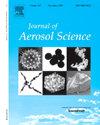Shrinkage ratios and effective densities of residues formed from drying of simulated expiratory droplets
IF 3.9
3区 环境科学与生态学
Q2 ENGINEERING, CHEMICAL
引用次数: 0
Abstract
The COVID-19 pandemic that afflicted the world recently has renewed the focus on transmission of respiratory diseases via aerosol route. An important question in this regard pertains to the size range of the droplets carrying virus that is most relevant to the transfer of pathogens released from an infected person in the course of respiratory activities, such as coughing, sneezing, speaking and breathing. The emitted droplets undergo rapid drying to form residues of nonvolatile solutes contained in the respiratory fluids. The residues may remain airborne or may settle on ground. The shrinkage ratio of the droplets have been investigated extensively to arrive at the airborne particle size range assuming typical solute concentrations in the saliva. In order to obtain a clearer understanding of the shrinkage process, it is important to examine the problem across a range of solute concentrations and test the measured shrinkage ratios against those predicted by mathematical models. From the perspective of residence times of a drying droplet in an enclosed space as well as for lung deposition, the aerodynamic diameters of the particles, rather than their physical diameters are a matter of significance, and the aerodynamic diameter is a sensitive function of the effective densities. The present work investigates both shrinkage ratios and effective densities of residue particles formed from saline solutions across a range of solute concentrations and compares the results with mathematical model of droplet drying and residue formation. The model is primarily tested for NaCl, which is most relevant to respiratory droplets, and as a part of its wider applicability, both experiments and models are compared for glucose as well. The experiments consist of subjecting the droplets placed on super-hydrophobic surfaces to evaporative drying under controlled ambient conditions at various solute concentrations. The mathematical model is based on solving the heat and mass transfer equations for drying of droplets, solute diffusion for build-up of concentration profiles and a critical supersaturation-based-nucleation model for crust formation leading to residues. The measured shrinkage ratios varied from 0.16 to 0.56 for NaCl across concentration of 2–80 kg/m3 and were in the range of 0.13–0.43 for glucose across the same range of concentrations. The model predictions agreed remarkably well with the experimental results leading closely to a concise formula: shrinkage ratio, , where, the effective density of the residue particle regardless of the concentration for NaCl in the fluid. A significant aspect of the study has been the close agreement between model predictions and measured shrinkage ratios. Interestingly, both measurements and model predictions suggest the formation of hollow particles with effective densities (independent of solute concentrations) well below the crystalline solid densities of the solutes. The implications of these results are discussed.
求助全文
约1分钟内获得全文
求助全文
来源期刊

Journal of Aerosol Science
环境科学-工程:化工
CiteScore
8.80
自引率
8.90%
发文量
127
审稿时长
35 days
期刊介绍:
Founded in 1970, the Journal of Aerosol Science considers itself the prime vehicle for the publication of original work as well as reviews related to fundamental and applied aerosol research, as well as aerosol instrumentation. Its content is directed at scientists working in engineering disciplines, as well as physics, chemistry, and environmental sciences.
The editors welcome submissions of papers describing recent experimental, numerical, and theoretical research related to the following topics:
1. Fundamental Aerosol Science.
2. Applied Aerosol Science.
3. Instrumentation & Measurement Methods.
 求助内容:
求助内容: 应助结果提醒方式:
应助结果提醒方式:


